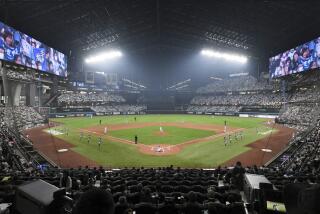The Challenge of Okinawa
- Share via
Okinawa’s 1.2 million people have long had cause for complaint. Their island, the largest in the Ryukyu chain, constitutes less than 1% of Japan’s land area. But crowded into that space are about half of the 47,000 U.S. troops stationed in Japan and three-fourths of the U.S. military bases that undergird the mutual defense treaty. If noise, congestion, intrusion on scarce arable land and occasional military aircraft accidents weren’t bad enough, Okinawans must also contend with an incidence of crime by Americans far higher than anything Japanese society produces. A year ago the problem took an especially vicious turn when three U.S. servicemen kidnapped and raped a schoolgirl.
This week Okinawans voted overwhelmingly in an advisory referendum to reduce the U.S. military presence. Washington again made clear its readiness to cooperate, even as it reaffirmed the importance of the bases to joint U.S.-Japanese strategic interests. Japan’s central government also moved to placate Okinawan opinion, with Prime Minister Ryutaro Hashimoto offering $46 million in development funds. Now, as always, Okinawa’s economy woefully lags that of the four main islands; Okinawans, on average, have only about half the income of Tokyo residents.
More to the point, Hashimoto said he would redouble efforts to find sites elsewhere in Japan for some of the Okinawa bases. But that pledge is easier made than honored, since few Japanese are eager to have the bases anywhere near them.
Tokyo and Washington agree that their security interests require a continued strong U.S. military presence. They also agree that a reduced reliance on Okinawa bases is desirable. The challenge for Hashimoto or his successor is to shape the political consensus that’s needed to shift some U.S. forces from Okinawa to the main islands.
More to Read
Sign up for Essential California
The most important California stories and recommendations in your inbox every morning.
You may occasionally receive promotional content from the Los Angeles Times.













